|
Compound class:
Synthetic organic
Comment: AH10-7 is a sphinganine α-galactosylceramide (or galactosylsphingamide) that has been designed for the potential to activate CD1d-restricted invariant natural killer T (iNKT) cells as a mechanism to augment immune responses against cancer and infections [1]. It is an analogue of KRN7000 (PubChem CID 2826713, a.k.a. α-GalCer) that was originally developed for its potent immunomodulatory effects, and which was investigated as an immuno-oncology agent [3,7]. However, KRN7000 induces both Th1 and Th2 cytokine production, and produces a suboptimal immune response, which likely accounts for its apparent limited efficacy in clinical trials [5,8]. AH10-7 overcomes KRN7000's unpredictable effects by promoting a Th1-biased immune response, which suggests that it will elicit more favorable results against cancer and infection (whereas a Th2-biased response would likely be of more benefit against autoimmune diseases). Both KRN7000 and AH10-7 are ligands for the lipid-binding MHC class I-like protein CD1d. Recognition of lipid-based antigens presented by CD1d sets iNKT cells apart from conventional T cells.
Van Kaer and Wu (2018) have published a review of the therapeutic potential of iNKT cells in autoimmune conditions [6] and the application of unconventional T cells in immuno-oncology is reviewed by Godfrey et al. (2018) [2] and Krijgsman et al. (2018) [4]. |
|
|||||||||||||||||||||||||||||||||||
| References |
|
1. Chennamadhavuni D, Saavedra-Avila NA, Carreño LJ, Guberman-Pfeffer MJ, Arora P, Yongqing T, Koay HF, Godfrey DI, Keshipeddy S, Richardson SK et al.. (2018)
Dual Modifications of α-Galactosylceramide Synergize to Promote Activation of Human Invariant Natural Killer T Cells and Stimulate Anti-tumor Immunity. Cell Chem Biol, 25 (5): 571-584.e8. [PMID:29576533] |
|
2. Godfrey DI, Le Nours J, Andrews DM, Uldrich AP, Rossjohn J. (2018)
Unconventional T Cell Targets for Cancer Immunotherapy. Immunity, 48 (3): 453-473. [PMID:29562195] |
|
3. Kobayashi E, Motoki K, Uchida T, Fukushima H, Koezuka Y. (1995)
KRN7000, a novel immunomodulator, and its antitumor activities. Oncol Res, 7 (10-11): 529-34. [PMID:8866665] |
|
4. Krijgsman D, Hokland M, Kuppen PJK. (2018)
The Role of Natural Killer T Cells in Cancer-A Phenotypical and Functional Approach. Front Immunol, 9: 367. [PMID:29535734] |
|
5. Nair S, Dhodapkar MV. (2017)
Natural Killer T Cells in Cancer Immunotherapy. Front Immunol, 8: 1178. [PMID:29018445] |
|
6. Van Kaer L, Wu L. (2018)
Therapeutic Potential of Invariant Natural Killer T Cells in Autoimmunity. Front Immunol, 9: 519. [PMID:29593743] |
|
7. Yamaguchi Y, Motoki K, Ueno H, Maeda K, Kobayashi E, Inoue H, Fukushima H, Koezuka Y. (1996)
Enhancing effects of (2S,3S,4R)-1-O-(alpha-D-galactopyranosyl)-2-(N-hexacosanoylamino) -1,3,4-octadecanetriol (KRN7000) on antigen-presenting function of antigen-presenting cells and antimetastatic activity of KRN7000-pretreated antigen-presenting cells. Oncol Res, 8 (10-11): 399-407. [PMID:9114432] |
|
8. Yu KO, Porcelli SA. (2005)
The diverse functions of CD1d-restricted NKT cells and their potential for immunotherapy. Immunol Lett, 100 (1): 42-55. [PMID:16083968] |








